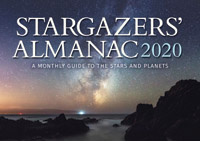Quick Look
-- Perfect for beginners
-- Perfect for children
-- No telescope required
- Perfect for children and beginners
- Explore the night skies with this beautifully illustrated monthly guide to the stars and planets
- Has a loop and eyelet for easy wall hanging, and is presented in a sturdy cardboard gift envelope
- 'A very good, very useful Almanac.' Sir Patrick Moore
A beautiful illustrated monthly guide to exploring the stars and planets without a telescope.
Description
Explore the night skies with this beautiful illustrated monthly guide to the stars and planets.
This large-format almanac allows you to step outside and track the planets, locate the Milky Way, recognise the constellations of the zodiac and watch meteor showers.
Stargazers' Almanac 2020 is a beautiful month-by-month guide to the night skies. It's designed specifically for naked-eye astronomy -- no telescope required! -- making it ideal for beginners, children and backyard astronomers. It is a perennially popular Christmas gift -- and one which lasts the whole year round.
Each monthly chart features two views of the night sky, looking north and south, and a visual guide to the phases of the moon and the movements of the planets.
Stargazers' Almanac 2020 also features:
-- Advice on how to navigate the night sky
-- Overhead reference map of the sky
-- Reference plan of constellations
-- Glossary of constellations and Latin names
-- Glossary of brightness of stars
-- Guide to the signs of the zodiac and how they relate to the stars
-- Loop and eyelet for easy wall hanging; presented in a sturdy cardboard gift envelope
Suitable for astronomy enthusiasts throughout the Northern Hemisphere's temperate (non-tropical) latitudes.
Reviews
'A very good, very useful Almanac.'
-- Sir Patrick Moore
'A beautiful, informative spread for every month of the year.'
-- Green Parent
'There is a lot of information concisely offered on each well-designed page... The illustrations of the zodiacal constellations are clear and attractive, and the whole format inspires and encourages an interest in getting out to see what can be seen in the heavens when the stars are out.'
-- Journal of the Society of the Inner Light
'An almanac such as this can be a great blessing and encourage a sense of wonder at the heavens… The almanac will make an attractive and informative present, especially for a young person, to get them interested and involved in actual viewing'
-- Margaret Jones, New View
'With this in hand you should be able to explore the night sky and sort out Andromeda from Perseus … I really felt that with this in my hand I could find my way around the sky as I never have before … this is a really valuable asset to the amateur astronomer and a good gift for anyone with even the slightest interest in the stars. *****'
-- Brian Clegg, www.popularscience.co.uk
'Now a regular player on the night-sky-watching scene, the Stargazers' Almanac is in good time to be selected as a Christmas gift for anyone with the slightest interest in what is going on "up there"… a very worthwhile publication.'
-- David Stickland, The Observatory Magazine
'An attractive, user-friendly, understandable guide.'
-- Robert Key, MP
'This calendar has a place in the study or library as a reminder of what's up in the sky, and has popular appeal especially for newcomers to astronomy.'
-- Maurice Gavin, Journal of the British Astronomical Association
'Practical, nice to look at and suitable for all levels of skywatcher, I recommend the Stargazers’ Almanac.'
-- Peter Grego, Popular Astronomy
'This Almanac will show you the wonders of the night sky, a sight that is becoming ever more precious with light pollution often masking our view.'
-- Bill Bryson
Author
Bob Mizon, MBE, is co-ordinator of the Commission for Dark Skies. He was elected a Fellow of the Royal Astronomical Society in 1985, and has been associated with the Wessex Astronomical Society in various offices for many years. Since 1996, he has provided a full-time mobile planetarium service to south central England, and has taken the experience of the night sky to nearly 160,000 people, mostly schoolchildren.

